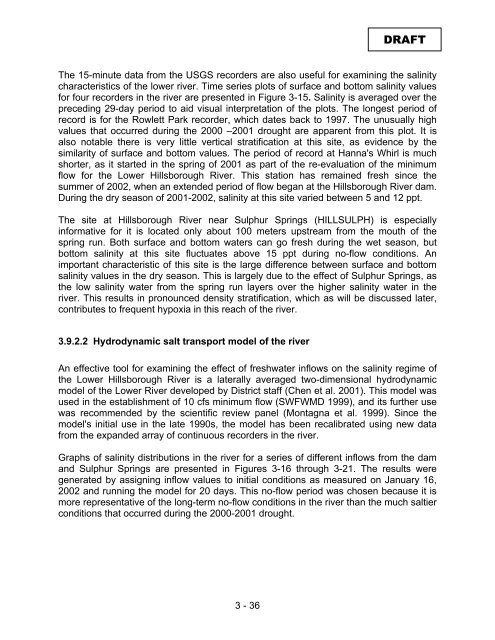The Determination of Minimum Flows for Sulphur Springs, Tampa
The Determination of Minimum Flows for Sulphur Springs, Tampa
The Determination of Minimum Flows for Sulphur Springs, Tampa
You also want an ePaper? Increase the reach of your titles
YUMPU automatically turns print PDFs into web optimized ePapers that Google loves.
DRAFT<br />
<strong>The</strong> 15-minute data from the USGS recorders are also useful <strong>for</strong> examining the salinity<br />
characteristics <strong>of</strong> the lower river. Time series plots <strong>of</strong> surface and bottom salinity values<br />
<strong>for</strong> four recorders in the river are presented in Figure 3-15. Salinity is averaged over the<br />
preceding 29-day period to aid visual interpretation <strong>of</strong> the plots. <strong>The</strong> longest period <strong>of</strong><br />
record is <strong>for</strong> the Rowlett Park recorder, which dates back to 1997. <strong>The</strong> unusually high<br />
values that occurred during the 2000 –2001 drought are apparent from this plot. It is<br />
also notable there is very little vertical stratification at this site, as evidence by the<br />
similarity <strong>of</strong> surface and bottom values. <strong>The</strong> period <strong>of</strong> record at Hanna's Whirl is much<br />
shorter, as it started in the spring <strong>of</strong> 2001 as part <strong>of</strong> the re-evaluation <strong>of</strong> the minimum<br />
flow <strong>for</strong> the Lower Hillsborough River. This station has remained fresh since the<br />
summer <strong>of</strong> 2002, when an extended period <strong>of</strong> flow began at the Hillsborough River dam.<br />
During the dry season <strong>of</strong> 2001-2002, salinity at this site varied between 5 and 12 ppt.<br />
<strong>The</strong> site at Hillsborough River near <strong>Sulphur</strong> <strong>Springs</strong> (HILLSULPH) is especially<br />
in<strong>for</strong>mative <strong>for</strong> it is located only about 100 meters upstream from the mouth <strong>of</strong> the<br />
spring run. Both surface and bottom waters can go fresh during the wet season, but<br />
bottom salinity at this site fluctuates above 15 ppt during no-flow conditions. An<br />
important characteristic <strong>of</strong> this site is the large difference between surface and bottom<br />
salinity values in the dry season. This is largely due to the effect <strong>of</strong> <strong>Sulphur</strong> <strong>Springs</strong>, as<br />
the low salinity water from the spring run layers over the higher salinity water in the<br />
river. This results in pronounced density stratification, which as will be discussed later,<br />
contributes to frequent hypoxia in this reach <strong>of</strong> the river.<br />
3.9.2.2 Hydrodynamic salt transport model <strong>of</strong> the river<br />
An effective tool <strong>for</strong> examining the effect <strong>of</strong> freshwater inflows on the salinity regime <strong>of</strong><br />
the Lower Hillsborough River is a laterally averaged two-dimensional hydrodynamic<br />
model <strong>of</strong> the Lower River developed by District staff (Chen et al. 2001). This model was<br />
used in the establishment <strong>of</strong> 10 cfs minimum flow (SWFWMD 1999), and its further use<br />
was recommended by the scientific review panel (Montagna et al. 1999). Since the<br />
model's initial use in the late 1990s, the model has been recalibrated using new data<br />
from the expanded array <strong>of</strong> continuous recorders in the river.<br />
Graphs <strong>of</strong> salinity distributions in the river <strong>for</strong> a series <strong>of</strong> different inflows from the dam<br />
and <strong>Sulphur</strong> <strong>Springs</strong> are presented in Figures 3-16 through 3-21. <strong>The</strong> results were<br />
generated by assigning inflow values to initial conditions as measured on January 16,<br />
2002 and running the model <strong>for</strong> 20 days. This no-flow period was chosen because it is<br />
more representative <strong>of</strong> the long-term no-flow conditions in the river than the much saltier<br />
conditions that occurred during the 2000-2001 drought.<br />
3 - 36

















